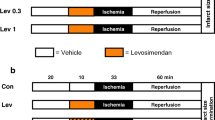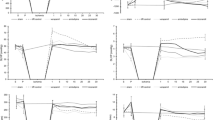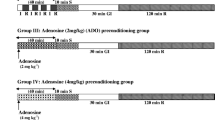Summary
Experiments were carried out to test the hypothesis that preconditioning reduces the impairment of recovery of cardiac mechanical function and that this effect is mediated by activation of adenosine A1 receptors. Isolated hearts were Langendorff-perfused at 37°C with oxygenated blood and paced at 3 Hz. They were divided into 5 groups, all subjected to 45 min global ischemia followed by one hour of reperfusion: 1) Control hearts (n=7) which received no treatment or short ischemia before the long ischemia, 2) preconditioned hearts (n=7), submitted to 5-min zero-flow global ischemia, followed by 5 min reperfusion before the long ischemia, 3) hearts pretreated with sulfophenyltheophylline (SPT 100 μM) before preconditioning and long ischemia (n=6), 4) hearts in which preconditioning was substituted by administration of 10 μM phenyl-isopropyl-adenosine (PIA) over 5 min, and 5) hearts in which preconditioning was substituted by the administration of 1.5 mg adenosine over 5 min. Hemodynamic results show significant improvement of the postischemic recovery of left ventricular developed pressure (DP) by preconditioning. SPT pretreatment did not reverse the improvement of recovery, obtained by preconditioning, whereas PIA treatment could not mimic preconditioning. Adenosine treatment caused some improvement of recovery of DP, but which remained lower compared to that caused by preconditioning. The contracture developed during ischemia persisted in control hearts, whereas contracture disappeared in non-treated preconditioned hearts. SPT did not prevent the decrease in contracture by preconditioning although values remained slightly higher than in the nontreated preconditioned hearts. PIA did not substitute for preconditioning in preventing contracture. In the adenosine treated group, some decrease of contracture occurred during reperfusion, but values remained significantly higher than in preconditioning.
We conclude that receptor A1 activation is not the main mechanism underlying improved functional recovery conferred by preconditioning since an A1 receptor blocker (SPT) cannot reverse the effect of preconditioning and an A1 receptor agonist (PIA) cannot mimic it. Administration of exogenous adenosine reduces functional impairment to a certain extent, but less than preconditioning.
Similar content being viewed by others
References
Asimakis GK, Inners-McBride K, Medellin G, Conti VR (1992) Ischemic preconditioning attenuates acidosis and postischemic dysfunction in isolated rat heart. Am J Physiol 263:H887-H894
Cave AC, Downey JM, Hearse DJ (1991) Adenosine fails to substitute for preconditioning in the globally ischemic rat heart. J Mol Cell Cardiol 23 (Suppl III):S76 (abstract)
Cohen MV, Liu GS, Downey JM (1991) Preconditioning causes improved wall motion as well as smaller infarcts after transient coronary occlusion in rabbits. Circulation 84:341–349
Daut J, Maier-Rudolph W, Von Beckerath N, Mehrke G, Gunther K, Goedel-Meinen L (1990) Hypoxic dilatation of coronary arteries is mediated by ATP-sensitive potassium channels. Science 247:1341–1344
Dorheim TA, Hoffman A, Van Wylen DGL, Mentzer RM (1991) Enhanced interstitial fluid adenosine attenuates myocardial stunning. Surgery 110:136–145
Downey JM, Jordan M (1989) Preconditioning limits infarct size in rabbits. Circulation 80 (Suppl II):II-238 (abstract)
Fenton RA, Bruttig SP, Rubio R, Berne RM (1982) Effect of adenosine on calcium uptake by intact and cultured vascular smooth muscle. Am J Physiol 242 (Heart Circ Physiol 220):H797-H804
Flameng W, Andres J, Ferdinande P, Mattheussen M, Van Belle H (1991) Mitochondrial function in myocardial stunning. J Mol Cell Cardiol 21:1–11
Gross GJ, Auchampach JA (1992) Blockade of ATP-sensitive potassium channels prevents myocardial preconditioning in dogs. Circ Res 70:223–233
Hopwood AM, Harding SE, Harris P (1987) An antiadrenergic effect of adenosine on guinea-pig but not rabbit ventricles. Eur J Pharmacol 137:67–75
Iwamoto T, Miura T, Adachi T, Noto T, Ogawa T, Tsuchida A, Jimura O (1991) Myocardial infarct size-limiting effect of ischemic preconditioning was not attenuated by oxygen free-radical scavengers in the rabbit. Circulation 83:1015–1022
Kaplan P, Hendrikx M, Mattheusen M, Mubagwa K, Flameng W (1992) Effect of ischemia and reperfusion on sarcoplasmic reticulum calcium uptake. Circ Res 71:1123–1130
Kida M, Fujiwara H, Ishida M, Kawai C, Ohura M, Miura I, Yabuuchi Y (1991) Ischemic preconditioning preserves creatine phosphate and intracellular pH. Circulation 84:2495–2503
Kihara Y, Grossman W, Morgan JE (1989) Direct measurement of changes in intracellular Ca++ transient during hypoxia, ischemia and reperfusion in intact mammalian heart. Circ Res 65:1029–1044
Kimura Y, Iyengar J, Subramanian R, Cordis GA, Das DK (1992) Preconditioning of the heart by repeated stunning: attenuation of post-ischemic dysfunction. Bas Res Cardiol 87:128–138
Kitakaze M, Hori M, Takashima S, Sato H, Kamada T (1991) Augmentation of adenosine production during ischemia as a possible mechanism of myocardial protection in ischemic preconditioning. Circulation 84 (Suppl II):306 (abstract)
Kupriyanov VV, Lakomkim VL, Steinschneider AYA, Severina MYU, Kapelko VI, Ruuge FK, Saks VA (1988) Relationships between pre-ischemic ATP and glycogen content and post-ischemic recovery of rat heart. J Mol Cell Cardiol 20:1151–1162
Lasley RD, Rhee JW, Van Wylen DGL, Mentzer RM Jr (1990) Adenosine A1 receptor mediated protection of the globally ischemic isolated rat heart. J Mol Cell Cardiol 22:39–47
Li GC, Vasquez JA, Gallagher KP, Lucchesi BR (1990) Myocardial protection with preconditioning. Circulation 82:609–619
Li Y, Kloner R (1992) Ischemic “preconditioning” is not mediated by adenosine receptors in the rat heart. Circulation 86 (Suppl I):24 (abstract)
Liu GS, Thornton J, Van Winkle DM, Stanley AWH, Olsson RA, Downey JM (1991) Protection against infarction afforded by preconditioning is mediated by A1 adenosine receptors in the rabbit heart. Circulation 84:350–356
Marban E, Kitakaze M, Koretsune Y, Yue DT, Chacko VP, Pike MM (1990) Quantification of [Ca2+] in perfused hearts. Critical evaluation of the 5F-BAPTA and nuclear magnetic resonance method as applied to the study of ischemia and reperfusion. Circ Res 66: 1255–1267
Masuda M, Demeulemeester A, Chen C-C, Hendrikx M, Van Belle H, Flameng W (1991) Cardioprotective effects of nucleoside transport inhibition in rabbit hearts. Ann Thorac Surg 52:1300–1305
Miura T, Yellon DM, Hearse DJ, Downey JM (1987) Determinants of infarct size during permanent occlusion of a coronary artery in closed chest dogs. J Am Coll Cardiol 9:647–654
Murry CE, Jennings RB, Reimer KA (1986) Preconditioning with ischemia: a delay of lethal cell injury in ischemic myocardium. Circulation 74:1124–1136
Murry CE, Richard VJ, Reimer KA, Jennings RB (1990) Ischemic preconditioning slows energy metabolism and delays ultrastructural damage during a sustained ischemic period. Circ Res 66:913–931
Omar BA, Bose SK, McCord J (1991) Seasonal variation in myocardial postischemic injury. Cor Artery Dis 2:481–485
Omar BA, Hanson A, Bose S, McCord J (1991) Reperfusion with pyruvate eliminates ischemic preconditioning: an apparent role for enhanced glycolysis. Faseb J 5 (5):A1257 (abstract)
Ovize M, Przyklenk K, Hale SL, Kloner RA (1992) Preconditioning does not attenuate myocardial stunning. Circulation 85:2247–2254
Reimer KA, Jennings RB (1992) Preconditioning. Definitions, proposed mechanisms, and implications for myocardial protection in ischemia and reperfusion. In: Yellon DM, Jennings RB (eds) Myocardial protection: the pathophysiology of reperfusion and reperfusion injury. Raven Press, New York, pp 165–183
Rubanyi G, Romero JC, Vanhoutte PM (1986) Flow-induced release of endothelium-derived relaxing factor. Am J Physiol 250 (Heart Circ Physiol 19):H1145-H1149
Schott RJ, Rohmann S, Braun ER, Schaper W (1990) Ischemic preconditioning reduces infarct size in swine myocardium. Circ Res 66:1133–1142
Schwarz ER, Mohri M, Sack S, Arras M (1991) The role of adenosine and its A1 receptor in ischemic preconditioning. Circulation 84 (Suppl II):306 (abstract)
Shiki K, Hearse DJ (1987) Preconditioning of ischemic myocardium: reperfusion-induced arrhythmias. Am J Physiol 253 (Heart Circ Physiol 22):H1470-H1476
Steenbergen C, Murphy E, Levy L, London RE (1987) Elevation in cytosolic free calcium concentration early in myocardial ischemia in perfused rat heart. Circ Res 60:700–707
Steenbergen C, Perlman ME, London RE, Murphy E (1993) Mechanisms of preconditioning. Ionic alterations. Circ Res 72:112–125
Tani M, Neely JR (1989) Role of intracellular Na+ in Ca2+ overload and depressed recovery of ventricular function of reperfused ischemic rat hearts. Possible involvement of H+−Na+ and Na+−Ca2+ exchange. Circ Res 65:1045–1056
Thornton JD, Liu GS, Olsson RA, Downey JM (1992) Intravenous pretreatment with A1-selective adenosine analogues protects the hearts against infarction. Circulation 85:659–665
Thornton JD, Thornton CS, Sterling DL, Downey JM (1993) Blockade of ATP-sensitive potassium channels increases infarct size but does not prevent preconditioning in rabbit hearts. Circ Res 72:44–49
Tsuchida A, Miura T, Miki T, Kazuaki S, Iimura O (1992) Role of adenosine receptor activation in myocardial infarct size limitation by ischaemic preconditioning. Cardiovasc Res 26:456–461
Vander Heide R, Steenbergen C, Fralix T, London R, Murphy E (1991) The rise in Cai during ischemia is lessened by preconditioning. A possible role for Na/H and Na/Ca exchange. J Cell Mol Cardiol 23 (Suppl III):S.21 (abstract)
Von Beckerath N, Cyrys S, Dischner A, Daut J (1991) Hypoxic vasodilatation in isolated, perfused guinea-pig heart: an analysis of the underlying mechanisms. J Physiol 442:297–319
Wolfe CL, Sievers RE, Visseren FLJ, Donnelly TJ (1993) Loss of myocardial protection after preconditioning correlates with the time course of glycogen recovery within the preconditioned segment. Circulation 87:881–892
Zhu G-Y, Chen S-G, Zou C-M (1990) Protective effect of an adenosine deaminase inhibitor on ischemia-reperfusion injury in isolated perfused rat heart. Am J Physiol 259 (Heart Circ Physiol 28):H835-H838
Author information
Authors and Affiliations
Rights and permissions
About this article
Cite this article
Hendrikx, M., Toshima, Y., Mubagwa, K. et al. Improved functional recovery after ischemic preconditioning in the globally ischemic rabbit heart is not mediated by adenosine A1 receptor activation. Basic Res Cardiol 88, 576–593 (1993). https://doi.org/10.1007/BF00788876
Received:
Accepted:
Issue Date:
DOI: https://doi.org/10.1007/BF00788876




